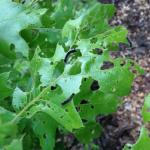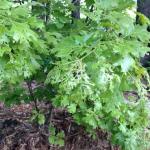HAPPY MEMORIAL DAY WEEKEND! Remember the sacrifices of our Veterans!
UMass Extension's Landscape Message is an educational newsletter intended to inform and guide Massachusetts Green Industry professionals in the management of our collective landscape. Detailed reports from scouts and Extension specialists on growing conditions, pest activity, and cultural practices for the management of woody ornamentals, trees, and turf are regular features. The following issue has been updated to provide timely management information and the latest regional news and environmental data.
To read individual sections of the message, click on the section headings below to expand the content:
Scouting Information by Region
Environmental Data
The following data was collected on or about May 23, 2018. Total accumulated growing degree days (GDD) represent the heating units above a 50° F baseline temperature collected via our instruments for the 2018 calendar year. This information is intended for use as a guide for monitoring the developmental stages of pests in your location and planning management strategies accordingly.
|
MA Region/Location |
GDD |
Soil Temp |
Precipitation |
Time/Date of Readings |
||
|
1-Week Gain |
2018 Total |
Sun |
Shade |
|||
|
Cape Cod |
53 |
196 |
64 |
59 |
0.75 |
3:00 PM 5/23 |
|
Southeast |
55 |
236 |
63 |
58 |
0.62 |
9:00 PM 5/23 |
|
North Shore |
74 |
329 |
58 |
54 |
0.33 |
9:15 AM 5/23 |
|
East |
61 |
318 |
71 |
61 |
0.40 |
4:30 PM 5/23 |
|
Metro West |
n/a |
334 |
56 |
54 |
0.61 |
5:45 AM 5/23 |
|
Central |
52 |
222 |
53 |
50 |
0.32 |
7:00 AM 5/23 |
|
Pioneer Valley |
75 |
301 |
64 |
60 |
0.59 |
10:00 AM 5/23 |
|
Berkshires |
74 |
268 |
61 |
57 |
0.61 |
8:15 AM 5/23 |
|
AVERAGE |
97 |
276 |
61 |
57 |
0.53 |
- |
|
n/a = information not available |
||||||
Phenology
| Indicator Plants - Stages of Flowering (BEGIN, BEGIN/FULL, FULL, FULL/END, END) | ||||||||
|---|---|---|---|---|---|---|---|---|
| PLANT NAME (Botanic/ Common) | CAPE | S.E. | N.S. | EAST | METRO W. | CENT. | P.V. | BERK. |
|
Kolkwitzia amabilis (beautybush) |
* |
* |
* |
Begin |
* |
* |
* |
* |
|
Weigela florida (old fashioned Weigela) |
* |
Begin |
Begin |
Begin |
* |
Begin |
Begin |
* |
|
Deutzia spp. (Deutzia species) |
* |
Begin |
Begin |
Begin |
* |
Begin |
Begin |
Begin |
|
Enkianthus campanulatus (redvein Enkianthus) |
Begin |
Full |
Begin/Full |
Begin/Full |
* |
Begin/Full |
Begin/Full |
Begin |
|
Rhododendron carolinianum (Carolina rhododendron) |
Begin |
Begin |
Full |
Begin |
* |
* |
* |
* |
|
Rhododendron catawbiense (Catawba rhododendron) |
Begin |
Begin |
Full |
Begin |
* |
Begin |
Full |
Begin |
|
Aesculus hippocastanum (common horsechestnut) |
Begin/Full |
Full |
Full |
Full |
Full |
Full |
Full |
Begin/Full |
|
Elaeagnus umbellata (Autumn-olive) |
Full |
Full |
Full |
Full |
Full |
Begin/ Full |
Full |
Begin |
|
Spiraea x vanhouttei (Vanhoutte spirea) |
Begin/Full |
Full |
Full |
Begin |
Full |
Full |
Full/End |
Begin |
|
Syringa vulgaris (common lilac) |
Full |
End |
Full |
End |
Full |
Full |
Full/End |
Full |
|
Rhododendron spp. (early azaleas) |
Full |
* |
Full/End |
Full/End |
Full |
Full |
* |
* |
|
Cornus florida (flowering dogwood) |
Full |
* |
Full |
End |
Full |
Full |
Full/End |
* |
| * = no activity to report/information not available | ||||||||
Regional Notes
Cape Cod Region (Barnstable)
General Conditions: The average temperature over the period was 57°F with a high of 72°F on May 23 and a low of 39°F on May 19. Three quarters of an inch of precipitation fell during the period with most occurring on May 17 and May 20. Topsoil and subsoil moisture conditions remain adequate.
Pests/Problems: Winter moth caterpillars continue to develop and can be found on susceptible hosts. Gypsy moth can be found on the outer Cape. Other pests or damage observed over the last week include: viburnum leaf beetle (Pyrrhalta viburni) on viburnum, rose slug sawfly on rose, fungal needle casts on white pine, boxwood psyllid (Psylla buxi) on boxwood, boxwood leafminer (Monarthropalpus flavus), larvae on boxwood, spruce spider mite (Oligonychus ununguis) on spruce, eastern tent caterpillar (Malacosoma americanum) on cherry, verticillium on Japanese maple, slugs on bearded iris, botrytis on tulip. The following weeds are in bloom: autumn olive (Elaeagnus umbellata), bush honeysuckles (Lonicera spp), garlic mustard (Alliaria petiolata), mouse-ear chickweed (Cerastium vulgatum), yellow rocket (Barbarea vulgaris), henbit (Lamium spp). and Veronica spp.
Southeast Region (Hanson)
General Conditions: Nice spring weather continued this past week with only one night with a low temperature of 40 degrees. Soils were on the dry side last week; Hanson received 0.62 inches of rain and the area could use more. Continue to remind clients to water newly planted plants and lawns.
The following plants are in full bloom: Magnolia fraseri, late blooming magnolias, Aesculus pavia, Aesculus hippocastanum (common horsechestnut), Halesia sp., Rutgers hybrid dogwoods (Stellar series), Prunus serotina (black cherry), Calycanthus floridus (Carolina allspice), Syringa sp., Weigela florida ‘Variegata’, Lonicera japonica (invasive), Wisteria floribunda (Japanese wisteria), numerous viburnums, includingViburnum plicatum f. tomentosum (Doublefile file viburnum), Aristolochia durior (Dutchman's pipe), Kerria, Daphne x burkwoodii 'Carol Mackie', Cytisus scoparius (Scotch broom}, Persicaria bistorta ‘Superbum’, Corydalis lutea, Tiarella cordifolia (foam flower), Buglossoides purpurocaerulea, Geranium sp., Convallaria majalis (lily-of-the-valley), Epimedium sp., Cypripedium parviflorum (yellow lady’s slipper), Trillium sp., Galium odoratum (sweet woodruff), Amsonia sp., Brunnera macrophylla, Polygonatum sp. (Solomon's seal), Stylophorum diphyllum (wood poppy), Phlox subulata, Phlox stolonifera, Phlox divaricata, Arisaema dracontium, Arisaema ringens, and other Arisaema sp. (Jack-in-the-pulpit), Euphorbia polychroma, Doronicum sp., Ajuga, dwarf bearded Iris, Saruma henryi, Lamiastrum galeobdolon, Lamium sp., Dicentra spectabilis, Mertensia virginica (Virginia bluebells), Aquilegia sp. (Columbine), Salvia sp., Myosotis sylvatica (forget-me-not) and Vinca minor. Rhododendrons are beginning to bloom. Kousa dogwood flower bracts are expanding and starting to show color.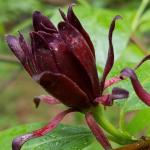
The following plants have ended or are ending bloom: Kwanzan cherry, Rhododendron ‘Olga Mezitt’, Cercis canadensis, Daphne tangutica, Exochorda racemosa, Viburnum carlesii (Mayflower viburnum), Viburnum x burkwoodii ‘Mohawk’, Crabapples Viburnum ‘Eskimo’, Fothergilla major (large Fothergilla), Fothergilla gardenii (dwarf Fothergilla)and Arisaema sikokianum. Ilex x meserveae (Meserve hybrid hollies) have ended bloom and the fruit set once again looks promising. Each year at about this time, American hollies shed their older (yellow) leaves; sometimes clients are unnecessarily concerned about this annual leaf shedding. Lawns continue to look green and lush, some growing so well that they need to be mowed twice per week! Remember, if using a preventative grub management product that contains Chlorantraniliprole (AceleprynTM, GrubEx), it is best applied before the end of May; follow the directions on the label before applying.
Now is a good time to remove seedlings of Massachusetts’ invasive plants like Norway maple, barberry, autumn olive and burning bush before they become established. It is also a good time to prune and/or shear barberry, autumn olive and burning bush to remove flowers and newly set seeds (or remove completely) to prevent further seed dispersal.
 Pests/Problems: Winter moth caterpillars remain active and are in mostly 4th instar, although there are a few 3rd and 5th instars. Winter moth caterpillars are at the lowest numbers seen since we started monitoring for them. However, gypsy moth caterpillars are abundant in many areas, although not easily seen at this stage. They remain small, at mostly 2nd and 3rd instars, and were observed feeding on a wide range of primarily deciduous plant material: oaks, beech, maples, roses, Fothergilla, crabapples, blueberry, etc. They were observed feeding on the undersides of the foliage. They will feed for several more weeks; manage early, while caterpillars are small and before damage is significant, especially those plants that were heavily damaged or defoliated last year. See the Insect Section of the Landscape Message.
Pests/Problems: Winter moth caterpillars remain active and are in mostly 4th instar, although there are a few 3rd and 5th instars. Winter moth caterpillars are at the lowest numbers seen since we started monitoring for them. However, gypsy moth caterpillars are abundant in many areas, although not easily seen at this stage. They remain small, at mostly 2nd and 3rd instars, and were observed feeding on a wide range of primarily deciduous plant material: oaks, beech, maples, roses, Fothergilla, crabapples, blueberry, etc. They were observed feeding on the undersides of the foliage. They will feed for several more weeks; manage early, while caterpillars are small and before damage is significant, especially those plants that were heavily damaged or defoliated last year. See the Insect Section of the Landscape Message.
Monitor the tips of Euonymus branches. Look for leaf tips webbed together, a sign of Euonymus caterpillars which web the leaf tips together and feed. Monitor Taxus and Meserve hollies for cottony Taxus scale (aka: cottony camellia scale). Roseslug sawfly remains active on roses and if left untreated, the sawfly larvae will skeletonize the rose foliage and the foliage will appear ‘burned’, resembling tan lace. Bt (Bacillus thuringiensis) is not effective on sawflies. Azalea sawfly larvae (photo) remain active on deciduous azaleas like Exbury azaleas and Weston hybrid summer azaleas. Look for the small, bright, glossy, green, caterpillar-like larvae which are often found feeding on the outer margin of a leaf, feeding inward, leaving only the midvein; manage early to avoid defoliation.
The following insects are active: lily leaf beetle, willow leaf beetles, boxwood psyllid, spruce spider mite, hemlock woolly adelgid, elongate hemlock scale (Fiorina scale), Eastern tent caterpillar; European pine sawfly, aphids, woolly beech aphid on beech, slugs, snails, ants, deer flies, wasps, hornets, mosquitoes,carpenter bees and dog ticks.
Deer tick nymphs remain active and will be active for a few months. Several people have mentioned they have pulled ticks off themselves and their dogs and cats. A few friends have reported they have Lyme disease. The deer tick nymph stage is often thought to be most responsible for transmitting Lyme disease. Repellents and frequent tick checks are recommended for everyone working or playing outdoors, especially in grassy areas or areas with leaf litter. See the Insect section of the Landscape Message.
Buttercups, ground ivy, garlic mustard, hawkweed, veronica, and chickweed are in full bloom. Dandelions are setting seed. The new reddish foliage of poison ivy is visible, as is the shiny green older foliage: “Leaves of three, let it be”.
Reports of extensive damage to the crowns of Hosta, Epimedium, Astilbe, etc. continue to come in. In many cases, entire plants have “disappeared” due to voles feeding. Winter damage to the foliage of some hollies and Rhododendrons is evident. Deer, wild turkeys, voles and chipmunks continue to be nuisances.
North Shore Region (Beverly)
General Conditions: Seasonable spring weather continued during this reporting period. Temperatures ranged from the mid 60s to mid-70s during the day and high 40s to mid-50s during the night. During this period, we gained 74 growing degree days for a total of 329 growing degree days since the beginning of the year. Approximately 1.59 inches of rain was received in Beverly during this period. Lawns are green and there is plenty of color in the landscape. Woody plants seen in bloom include: silver bell (Halesia carolina), Wright viburnum (Viburnum wrightii), handkerchief or dove tree (Davidia involucrata), wayfaring tree (Viburnum lantana), leatherleaf viburnum (Viburnum rhytidophyllum) , sweet bells (Leucothoe racemosa), pearlbush (Exochorda racemosa), redvein Enkianthus (Enkianthus campanulatus), flowering dogwood (Cornus florida), redbud (Cercis canadensis), little leaf lilac (Syringa microphylla), common lilac (Syringa vulgaris), common horse chestnut (Aesculus hippocastanum) carolina rhododendron (Rhododendron carolina), Catawba rhododendron (Rhododendron catawbiense) andhighbushblueberry (Vaccinium corymbosum). Non-woody plants seen in bloom include: scotch rose (Rosa spinosissima), fetterbush (Leucothoe fontanesiana), Vinca vine (Vinca major), forget-me-not (Myosotis sylvatica), tulips (Tulipa spp.), bleeding heart (Dicentra spectabilis), trout lily (Erythronium americanum), Siberian Iris (Iris sibirica), Trillium (Trillium grandiflorum), rock cress (Aubrieta deltoidea) and pig squeak (Bergenia cordifolia).
Pests/Problems: The larvae of viburnum leaf beetle (Pyrrhalta viburni) are getting larger and starting to cause serious damage on the leaves of susceptible viburnum cultivars. Leaves are starting to get skeletonized. Damage by winter moth caterpillars (Operophtera brumata) was observed on apple trees and maples. A patch of pachysandra (Pachysandra terminalis) was observed with what looked like symptoms of volutella blight (Pseudonectria pachysandricola). If you suspect volutella on pachysandra send a sample to the UMass Plant Diagnostic Lab: http://ag.umass.edu/services/plant-diagnostics-laboratory. Remove diseased plants and thin the bed. Remove fallen leaves and other debris that inhibits good air circulation. Apply a fungicide to protect plants when the weather is wet. Weeds are thriving on some lawns and landscapes. Weeds seen in bloom include: dandelion (Taraxacum officinale), ground ivy (Glechoma hederacea), purple deadnettle (Lamium purpureum) and blue violet (Viola spp.). Ticks and mosquitoes are very active. Make sure you apply repellents before going to work outdoors. Make sure you also remove any standing water to prevent mosquito breeding areas.
East Region (Boston)
General Conditions: This past week has been dry with fluctuating temperatures. Highs ranged from 55°F to 79°F, averaging 68°F and low temperatures ranged from 39°F to 53°F, averaging 48°F. We gained 60.5 GDDs this week to bring the total to 317.5 for the year. We received rain on two occasions, the majority falling on May 19, then a small shower on May 22; for a total gain of 0.40 inches this week. Spring blooms continue to put on a show.
Herbaceous plants in bloom include: Allium giganteum (giant onion), Allium schoenoprasum (chives), Amsonia hubrichtii (bluestar), Aquilegia canadensis (columbine), Aristolochia macrophylla (Dutchman’s pipe), Carex appalachica (Appalachian sedge), Clematis spp. (Clematis), Convallaria majalis (lily-of-the-valley), Dianthus spp. (pinks), Dicentra formosa (western bleeding-heart), Gaillardia spp. (blanket flower), Galium odoratum (sweet woodruff), Geranium macrorrhizum 'Bevan's Variety' (bigroot geranium), Iberis sempervirens (evergreen candytuft), Iris germanica (bearded iris) cultivars, Lamprocapnos spectabilis (bleeding heart), Maianthemum canadense (Canada mayflower), Nepeta spp. (catmint), Ornithogalum umbellatum (garden star-of-Bethlehem), Podophyllum peltatum (mayapple), and Polygonatum biflorum (smooth Solomon's seal).
Woody plants in bloom include Aesculus pavia (red buckeye), Calycanthus floridus (eastern sweetshrub), Cornus sericea (red osier dogwood), Davidia involucrata (dove-tree), Dipelta floribunda [Linnaea dipelta] (rosy dipelta), Kolkwitzia amabilis [Linnaea amabilis] (beautybush), Liriodendron tulipifera (tulip tree), Magnolia tripetala (umbrella magnolia), Photinia villosa (Oriental Photinia), Pinus pumila (dwarf Siberian pine), Pinus thunbergii (black pine), Prunus virginiana (chokecherry), Rhododendron minus (Piedmont rhododendron), Rh. ‘Mist Maiden’ (cultivar of rhododendron), Rosa amblyotis (erect prickle rose), R. hugonis (Father Hugo rose), Spiraea chinensis (Chinese spirea), Symplocos paniculata (Asiatic sweetleaf, sapphire-berry), Syringa vulgaris 'Prairie Petite' (prairie petite common lilac), Viburnum lobophyllum (viburnum), V. rufidulum (rusty blackhaw viburnum), Weigela hortensis (weigela), Wisteria spp. (wisteria) and Xanthoceras sorbifolium (shinyleaf yellowhorn).
Pests/Problems: Growing conditions have also been ideal for weeds. Over the last week Digitaria spp. (crabgrass) and Impatiens capensis (orange jewelweed) have germinated. Alliaria petiolata (garlic mustard) and Poa annua (annual bluegrass) are in seed throughout the landscape, both in mulched beds and turf areas. Other weeds producing seed include Capsella bursa-pastoris (shepherd's purse) and Plantago lanceolata (narrowleaf plantain). Woody invasives Euonymus alatus (burning bush) and Frangula alnus (buckthorn) are in bloom. Woody invasive Lonicera spp. is almost finished blooming; some plants have ripening red fruit. Abundant in turf are fruiting Taraxacum spp. (dandelion), flowering Glechoma hederacea (ground ivy), Ranunculus bulbosus (bulbous crowfoot) and Trifolium repens (white clover). The introduced edible Fragaria vesca (woodland strawberry) is in full bloom as is its non-edible distant cousin Duchesnea indica (mock strawberry). Currently releasing pollen are Betula spp. (birch), Fraxinus spp. (ash) and Pinus spp. (pine).
The increase in GDDs has also resulted in an abundance of insect activity. Winter moth caterpillars (Operophtera brumata) continue to feed and gain in size; gypsy moth caterpillars (Lymantria dispar) are not far behind. Many plants in the landscape are host to both of these foliage-feeding caterpillars. Eastern tent caterpillars (Malacosoma americanum) are feeding on rosaceous plants; their tents are visible in branch crotches. Euonymus webworm (Yponomeuta cagnagella) caterpillars are active on Euonymus spp. host plants; their webs and tents are gaining in size. Azalea sawfly larvae remain active, feeding on azalea foliage. Hydrangea leaftier (Olethreutes ferriferana) continue to form protective enclosures at the tips of hydrangea plants as they feed on young growth and flower buds. The foliage of susceptible viburnums are being skeletonized by viburnum leaf beetle larvae (Pyrrhalta viburni). Scarlet lily beetle (Lilioceris lilii) remain active on true lilies. Boxwood psyllid nymphs (Psylla buxi) are feeding on young leaves.
Metro West (Acton)
General Conditions: Typical spring-like temperatures continued into this reporting period. It was cool, hot, windy or wet on any given day. The highest temperature recorded for this week. The average monthly rainfall for May is 4.04” and as of the this week I have recorded 2.64”. The monthly average precipitation for May is of 4.04”! The landscape is filled with color and in some stage of bloom at this time are the following woody plants: Aesculus hippocastanum (Horsechestnut), Aronia arbutifolia (Black Chokecherry), Chaenomeles speciosa (Common Flowering Quince), Cornus florida (Dogwood), C. x rutgersensis 'Ruth Ellen' (Rutgers Hybrid Dogwood), Cornus sericea (Red Dosier Dogwood), Daphne x burkwoodii 'Carol Mackie' (Daphne), Fothergilla gardenii (Dwarf Fothergilla), F. major (Large Fothergilla), Halesia carolina ‘Arnold Pink’ (Arnold Pink Silverbell), Halesia tetraptera (Mountain Silverbell), Leucothoe axillaris (Coast Leucothoe), Magnolia 'Butterflies' (Butterflies Magnolia), M. 'Yellow Lantern (Yellow Lantern Magnolia), Prunus serotina (Black Cherry), Rhododendron spp. (Rhododendron and Azalea) including R. vaseyii (Pink shell Azalea), Spiraea spp. (Bridal Wreath), Syringa vulgaris (Common Lilac), Vaccinium angustifolium (Lowbush Blueberry), V. corymbosum (Highbush Blueberry) Viburnum x burkwoodii (Burkwood Viburnum) and V. x burkwoodii 'Mohawk' (Mohawk Burkwood Viburnum). Woody vines in bloom are: Aristolochia macrophylla (Dutchman’s Pipe), Clematis spp. (Clematis), and Wisteria spp. (Wisteria). Contributing even more color and interest to the landscape are some flowering herbaceous plants and spring ephemerals including: Ajuga reptans (Bugleweed), Aquilegia canadensis (Columbine), Allium spp. (Ornamental Flowering Onion), Amsonia hubrichtii (Arkansas Blue Star), Arisaema triphyllum (Jack-in-the-Pulpit), Aurinia saxatilis (Basket of Gold), Camassia scilloides (Wild Hyacinth), Chrysogonum virginianum (Green and Gold), Convallaria majalis (Lily of the Valley), Dianthus deltoides (Maiden Pinks), Dicentra eximia (Fringed Bleeding Heart), D. spectabilis (Old Fashioned Bleeding Heart), D. spectabilis ‘Alba’ (White flowering Old Fashioned Bleeding Heart), Dictamnus albus (Gas Plant), Epimedium x versicolor 'Niveum' (White Flowering Barrenwort), E. x versicolor 'Roseuem' (Pink Flowering Barrenwort), E. versicolor 'Sulphureum' (Yellow Flowering Barrenwort), Erythronium americanum (Yellow Trout-Lily), Gallium odoratum (Sweet Woodruff), Geranium maculatum (Wild Geranium), G. macrorrhizum (Bigroot Geranium), G. sanguineum (Cranesbill Geranium), Helleborus niger (Christmas Rose), Hyacinthoides hispanica (Wood Hyacinth), Iris germanica (Bearded Iris), Lamium maculatum (Dead Nettle), Linaria annua (Money Plant), Myosotis sylvatica (Forget-me-not), Nepeta spp. (Ornamental Catmint), Omphalodes verna (Blue-eyed Mary), Phlox divaricata (Canadian Phlox), P. stolonifera (Creeping Phlox), P. x subulata (Moss Phlox), Podophyllum peltatum (Mayapple), Polygonatum commutatum (Great Solomon Seal), P. odoratum 'Variegatum' (Variegated Solomon’s Seal), Primula spp. (Primrose), Pulmonaria longifolia (Lungwort), P. rubra (Salmon colored Lungwort), Salvia nemerosa (Salvia), Stylophorum diphyllum (Wood Poppy), Tiarella cordifolia (Foam Flower), Trillium erectum (Red Flowering Trillium), T. grandiflorum (WhiteFlowering Trillium), T. sessile (Toadshade Trillum), Tulipa spp. (Tulip), Uvularia sessilifolia (Bellflower), Veronica umbrosa ‘Georgia Blue’ (Speedwell), Vinca minor (Periwinkle), and Viola spp. (Violet).
Pests/Problems: Observed in the landscape this past week were the following: Winter moth caterpillars feeding on the foliage of Ulmus (Elm), Gypsy moth caterpillars feeding on the foliage of Corylus (Filbert) and Quercus (Oak) and Woolly Beech Aphid on the underside of European Beech leaves. Many weeds are in flower including some of the most invasive: Alliaria petiolata (Garlic Mustard), Berberis thunbergii (Barberry), Elaeagnus umbellata (Autumn-olive), Euonymous alatus (Burning Bush), Lonicera maackii (Amur Honeysuckle) and Rhamnus cathartica (Common Buckthorn). Other weeds seen in bloom are: Glechoma hederacea (Ground Ivy), and Lamium purpureum (Purple Dead Nettle). Toxicodendron radicans (Poison Ivy) continues to leaf out and it is fairly easy to detect its shiny red leaves of three. Ticks, mosquitoes and black flies are feeding and active.
Central Region (Boylston)
General Conditions: This week the weather has been seasonal with variable temperatures but nothing too extreme. Trees and shrubs in bloom for this week: flowering dogwood (Cornus florida), red osier dogwood (Cornus sericea), daphne (Daphne x burkwoodii 'Carol Mackie'), dwarf fothergilla (Fothergilla gardenii), large fothergilla (Fothergilla major), pink Carolina silverbell (Halesia Monticola Group ‘Rosea’), mountain silverbell (Halesia carolina), coast leucothoe (Leucothoe axillaris), butterflies magnolia (Magnolia 'Butterflies'), black cherry (Prunus serotina), Farges catalpa (Catalpa fargesii), rhododendron and azalea (Rhododendron species and cultivars) including pink shell azalea (Rhododendron vaseyii) , fragrant azalea (Rhododendron narcissiflora) and roseshell azalea (Rhodoendron prinophyllum), bridalwreath (Spiraea x vanhouttei), common lilac (Syringa vulgaris cultivars), lowbush blueberry (Vaccinium angustifolium), highbush blueberry (Vaccinium corymbosum), doublefile viburnum (Viburnum plicatum forma tomentosum).
Herbaceous perennials in bloom for this week: bugleweed (Ajuga reptans), columbine (Aquilegia canadensis), blue star (Amsonia tabernaemontana), lily of the valley (Convallaria majalis), old fashioned bleeding heart (Lamprocapnos spectabilis), white flowering old fashioned bleeding heart (Lamprocapnos spectabilis ‘Alba’), wild geranium (Geranium maculatum), bigroot geranium (Geranium macrorrhizum), cranesbill geranium (Geranium sanguineum), Canadian phlox (Phlox divaricata), creeping phlox (Phlox stolonifera), moss phlox (Phlox subulata), variegated Solomon’s seal (Polemonium odoratum 'Variegatum'), primrose (Primula), lungwort (Pulmonaria longifolia), foam flower (Tiarella cordifolia). Bulbs in bloom include Hyacinthoides hispanica (Spanish blue bells), large camas (Camassia leichtlinii) and ornamental flowering onion (Allium species).
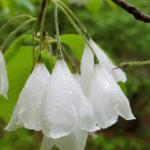
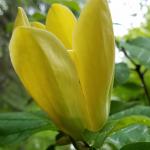

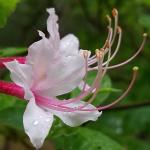
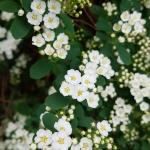
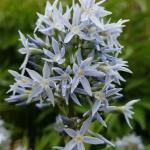
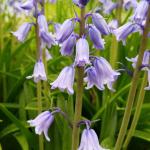
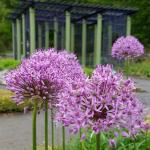
Pests/Problems: Gypsy moth caterpillar activity starting show significant damage on some leaves (photo credit April Tougas-Schavone). Ticks, mosquitoes, and blackfly still very active.
Pioneer Valley Region (Amherst)
General Conditions: Another week of variable spring weather, but overall, conditions have been very pleasant. We experienced our fourth (!) weekend in a row with at least one day of cool and rainy weather. This time, it was Saturday 5/19 when temperatures peaked in only the middle 50s. High temperatures have soared as high as the low 80s but humidity levels remain low and winds have been mostly light and variable. Low temperatures dropped into the 40s on 5/19 but otherwise have remained in the 50s to low 60s. Soils remain moist overall but surface soils can be dry depending on exposure and drainage class. Any recently transplanted trees and shrubs should be on a regular watering regime now as we inch closer to June. Landscape conifers such as spruce, hemlock, Douglas-fir, arborvitae and yew are really starting to fill in with new growth and tender shoots of the latter twoshould be protected from deer browsing. Lawn grasses continue to grow at a breakneck pace and with soil temperatures increasing every week, lawn weeds (including crabgrass) are abundant as well.
Pests/Problems: Gypsy moth feeding continues to be the biggest issue of concern at this early stage of the growing season. Second and third instar caterpillars can now be found and the resulting feeding damage is becoming more conspicuous on a variety of landscape trees. Heavy, localized defoliation has been observed on elm, oak and apple in the Amherst area. Feeding pressure continues to be worse east of the Connecticut River with only small numbers of caterpillars found on trees in western Hampshire County. As expected, eastern white pines are shedding large volumes of older needles at this time. Peak needle drop coincides with peak spore production and dispersal for the various needle blight pathogens that are driving the current decline epidemic. Nitrogen fertilization at this time may help to improve vigor for trees that have lost significant volumes of needles in recent years. Given the recent rainfall and high incidence and severity of anthracnose infections in 2017, we should expect to see foliar and stem cankering anthracnose infections developing soon. Look for collapsed, undersized foliage that is brown to blackened. Prune these blighted leaves and shoots out of the canopy as soon as possible on young and recently transplanted trees to reduce inoculum and disease development in the canopy. Viburnum leaf beetle larvae are actively feeding now with localized damage on mature shrubs observed. Treatment with spinosad is recommended at the larval stage since the mature adults will return to feed later in the season. Avoid spraying during active bloom when bees and other pollinators are present as spinosad is highly toxic to bees. Bladder gall mites are abundant now on landscape elms. While highly conspicuous, they cause little to no damage to infested trees. European pine sawflies are active and feed on a variety of hard pines, especially dwarf varieties of Scots and mugo. The small, green-colored caterpillars are well camouflaged against the dark green needles of their preferred hosts. The wood-rotting pathogen Polyporus squamosus is fruiting at this time (pictured in Disease section on a declining white mulberry on the UMass campus). Most wood-rotting fungi produce mushrooms and conks from mid to late summer onward, not in the spring. The heavy rainfall on 5/15 seems to have really set off mosquito populations in the area. Continue to scout for and turn over any receptacles harboring stagnant water that may serve as egg-laying site. Hemlocks continue to suffer in the Pioneer Valley with dieback and decline visible on many mature trees. Supplemental water may be required, even for mature trees, during this growing season as they try to recover from drought stress and winter injury, among other stresses.
Berkshire Region (Great Barrington)
General Conditions: Except for Saturday, May 19, a chilly damp day, temperatures were at or a little above normal for this time of year. Soil moisture in heavier soils remains high but not muddy. Silty loam soils also have good soil moisture levels. Thus, this remains a good time for planting trees, shrubs, and herbaceous plants. Though foliage development lags in most oaks, other trees and shrubs are nearly fully leafed. Lilacs currently dominant the floral landscape, but some may facetiously argue that dandelions provide the most color right now. Growth of turfgrass is rapid and lush. Caution should be taken not to cut grass at too low a height, i.e. scalping. This happens more frequently with homeowners who mow their lawns with the mistaken belief that a low cut will reduce the frequency of mowing.
Pests/Problems: Winter injury to rhododendron and holly foliage is more prominent now that new leaf growth has begun. Leaf spots have begun to show up on silver linden (Tilia tomentosa). Volutella blight was observed on foliage but not stems of pachysandra (Pachysandra terminalis) at a few sites but the extent of the affected groundcover was not great and could easily be rectified with judicious clipping of infected foliage. On the other hand, fire blight on sand cherry (Prunus x cistena) was quite severe with all the leaves of one observed specimen showing symptoms of the blight.
Pests observed this week include: imported willow leaf beetles (adults and larvae), boxwood leaf miner (larvae and pupae), Eastern tent caterpillar (actively feeding), woolly beech aphid (aggregating on the undersides of copper beech) and spruce spider mite. Adult deer ticks (a.k.a. black legged ticks) are extremely abundant as are mosquitoes, wasps and ants. Chipmunks and rabbits continue to dine on herbaceous vegetation and tender new growth of some shrubs.
Regional Scouting Credits
- CAPE COD REGION - Russell Norton, Horticulture and Agriculture Educator with Cape Cod Cooperative Extension, reporting from Barnstable.
- SOUTHEAST REGION - Deborah Swanson, UMass Extension Horticulturist for Plymouth County - Retired, reporting from Hanson.
- NORTH SHORE REGION - Geoffrey Njue, Green Industry Specialist, UMass Extension, reporting from the Long Hill Reservation, Beverly.
- EAST REGION - Kit Ganshaw & Sue Pfeiffer, Horticulturists, reporting from the Arnold Arboretum, Jamaica Plain.
- METRO WEST REGION - Julie Coop, Forester, Massachusetts Department of Conservation & Recreation, reporting from Acton.
- CENTRAL REGION - Dawn Davies, Interim Horticulture Manager, reporting from Tower Hill Botanic Garden, Boylston.
- PIONEER VALLEY REGION - Nick Brazee, Plant Pathologist, UMass Extension Plant Diagnostic Lab, reporting from UMass Amherst.
- BERKSHIRE REGION - Ron Kujawski, Horticultural Consultant, reporting from Great Barrington.
Woody Ornamentals
Diseases
Fire blight, caused by Erwinia amylovora, on Asian pear (Pyrus pyrifolia 'Shinsui'). Two-year-old tree that was planted in an orchard one year ago. Nearby trees had known fire blight infections when these trees were planted. Approximately 50-70% of the trunk circumference had blistering, blackened bark and the underlying sapwood was blackened and necrotic. The foliage was mostly healthy and the damage was confined entirely to the scion. The rootstock was clean and free of any necrosis.
Volutella leaf and stem blight (Volutella buxi), Macrophoma leaf spot (Dothiorella candollei) and boxwood mite (Eurytetranychus buxi) infestation of boxwood hybrids (Buxus spp.). Hundreds of boxwoods, approximately 5- to 20-years-old, in formal gardens at a large estate. The plants reside in both native and built soils with full sun and regular, overhead watering. All three pests have been a problem for several years and despite persistent intervention, dieback and decline continues. Overhead watering is often linked to disease problems for ornamental boxwoods. Free moisture on the surface of plant tissues allows spores to germinate and splashing and running water readily disperses spores.
Decline and dieback of a two-needle pine (Pinus sp.) caused by Diplodia sapinea, Phomopsis, and Sirococcus strobilinus. The tree is approximately 15-years-old and is growing at a coastal site with full sun surrounded by turfgrass that receives overhead watering. Diplodia was abundant on the cone scales but Phomopsis and Sirococcus were found on the blighted shoot tips. Sirococcus is most often found causing a shoot tip blight on conifers growing in coastal regions where fog is common.
Foliar anthracnose caused by Discula on sassafras (Sassafras albidum). Young nursery tree in a #7 container. Undersized leaves were blackened and collapsed. Large masses of white to cream-colored spores were present on the blighted leaves and petioles.
Infestation of the Norway spruce gall midge (Piceacecis abietiperda) on Norway spruce (Picea abies). Large and mature landscape tree, approximately 60- to 70-years-old. Last summer, canopy thinning, twig dieback and premature needle shedding was observed throughout the canopy, but more prominently in the upper canopy. The tree is roughly 10' from a neighboring property where a large volume of soil was added in an attempt to improve drainage, burying a large proportion of the tree’s surface roots. Additionally, the soil that was added is mostly clay and based on recent observations has actually made the drainage issue worse.
Report by Nick Brazee, Plant Pathologist, UMass Extension Plant Diagnostic Lab, UMass Amherst.
Insects
Woody ornamental insect and non-insect arthropod pests to consider, a selected few:
Busy Pollinators:
 European Honey Bee: (Apis mellifera) can be seen at plants currently in flower, including Rosa rugosa. This insect is native to parts of Eurasia and Africa and was introduced into North America during European colonization. Honey bees are excellent and important pollinators, and unlike other bees that occur in North America, honey bees maintain perennial colonies. These colonies are kept by beekeepers and hives are prized for honey production and beeswax, both of which are important commercial products. Hives can be moved to different locations and pollination services may be provided commercially for a wide variety of crops.
European Honey Bee: (Apis mellifera) can be seen at plants currently in flower, including Rosa rugosa. This insect is native to parts of Eurasia and Africa and was introduced into North America during European colonization. Honey bees are excellent and important pollinators, and unlike other bees that occur in North America, honey bees maintain perennial colonies. These colonies are kept by beekeepers and hives are prized for honey production and beeswax, both of which are important commercial products. Hives can be moved to different locations and pollination services may be provided commercially for a wide variety of crops.
Honey bees are not aggressive while foraging and can often be photographed with ease (if they stay at one flower long enough). These bees rarely sting unless their hive is disturbed or individual bees are accidentally trapped or handled. Honey bee stingers are barbed and therefore are pulled from the bee’s body following a sting, which results in the death of the bee. “Bee stings” are often incorrectly blamed on the European honey bee, when in actuality the culprit is often a wasp such as a yellowjacket. That being said, not all wasps are created equal, and many wasp species are completely incapable of stinging humans and provide many important ecosystem services including pollination and pest insect population control.
In addition to the European honey bee, many of our native pollinators are busy at work. An amur maple (Acer ginnala) in flower on 5/23/18 was literally buzzing with pollinators busily swarming the flowers. This included not only honey bees, but also bumble bees, carpenter bees, sweat bees and various wasp species.
Woody ornamental insect and non-insect arthropod pests to consider, a selected few:
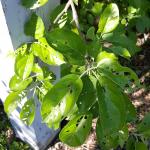
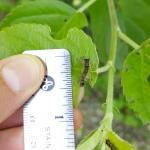

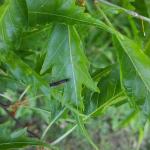
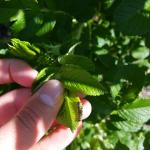
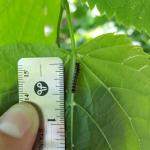 Gypsy Moth: (Lymantria dispar) Host plants include but are certainly not limited to oak (favored), maple, birch, poplar and many others. Gypsy moth caterpillars continue to feed and grow in size. Caterpillars observed on 5/23/18 in Amherst, MA are approximately ½ inch in length. Many are in the 2nd and 3rd instar. 3rd instar caterpillars are starting to develop some color and have noticeable bumps or warts that will eventually become the red and blue spots recognizable in older gypsy moth caterpillars. On 5/23/18 in Amherst, MA gypsy moth caterpillars were observed feeding on bur oak, elm, Norway maple, crabapple, fernleaf beech (Fagus sylvatica ‘Asplenifolia’), European linden, Rosa rugosa and apple. Feeding damage from gypsy moth is becoming more apparent and dark colored, hairy caterpillars can be seen on leaf undersides as well as leaf surfaces. While gypsy moth is still small (under ¾ inch in length, roughly) and actively feeding, and when weather conditions allow, it is a good time to treat caterpillars with Bacillus thuringiensis Kurstaki, or Btk. This active ingredient is derived from natural soil-dwelling bacteria and is specific to Lepidopteran caterpillars. Btk also offers lower risk to the applicator and the environment. (For more information about Btk, visit: http://npic.orst.edu/factsheets/btgen.html As caterpillars become larger and more visible (over ¾ inch in length), and create more damage to host plants, they are less susceptible to Btk.
Gypsy Moth: (Lymantria dispar) Host plants include but are certainly not limited to oak (favored), maple, birch, poplar and many others. Gypsy moth caterpillars continue to feed and grow in size. Caterpillars observed on 5/23/18 in Amherst, MA are approximately ½ inch in length. Many are in the 2nd and 3rd instar. 3rd instar caterpillars are starting to develop some color and have noticeable bumps or warts that will eventually become the red and blue spots recognizable in older gypsy moth caterpillars. On 5/23/18 in Amherst, MA gypsy moth caterpillars were observed feeding on bur oak, elm, Norway maple, crabapple, fernleaf beech (Fagus sylvatica ‘Asplenifolia’), European linden, Rosa rugosa and apple. Feeding damage from gypsy moth is becoming more apparent and dark colored, hairy caterpillars can be seen on leaf undersides as well as leaf surfaces. While gypsy moth is still small (under ¾ inch in length, roughly) and actively feeding, and when weather conditions allow, it is a good time to treat caterpillars with Bacillus thuringiensis Kurstaki, or Btk. This active ingredient is derived from natural soil-dwelling bacteria and is specific to Lepidopteran caterpillars. Btk also offers lower risk to the applicator and the environment. (For more information about Btk, visit: http://npic.orst.edu/factsheets/btgen.html As caterpillars become larger and more visible (over ¾ inch in length), and create more damage to host plants, they are less susceptible to Btk.
Despite the fungal outbreak that swept through the 2017 caterpillar population, some lucky caterpillars survived to pupation and emerged as adult moths. (However, adults were present in 2017 in far fewer numbers than would have existed without the fungus.) While it is very difficult to predict how much defoliation Massachusetts will see in 2018 due to gypsy moth caterpillar feeding, we can be certain that in areas where many egg masses were seen overwintering, pockets of defoliation could still occur in certain areas of the state this year. Thanks to the gypsy moth caterpillar-killing fungus, however, the population should be on the decline, but we cannot expect the caterpillars to disappear completely from Massachusetts landscapes this season.
- Winter Moth: (Operophtera brumata) The winter moth population is at a record low! The 2018 outlook concerning winter moth caterpillar population numbers in Massachusetts is very positive for those of you in the eastern areas of the state accustomed to dealing with damaging populations of this insect. Dr. Joseph Elkinton, Professor of Environmental Conservation at the University of Massachusetts, Amherst, MA, has excellent news: data from his lab’s research locations in eastern Massachusetts suggest that this invasive pest’s population size is at an all-time low. In fact, the 2017 winter moth population was the lowest they have seen since studying and working toward the biological control of this insect for the past 13 years.
Winter moth caterpillars, where they can be found in eastern Massachusetts, continue to feed and grow in size. For region-specific information, see the Scouting Reports above. Winter moth caterpillars will soon drop from feeding on host plants to the soil surface, where they will pupate. Caterpillars typically do this when they are approximately 1 inch in length around late-May or early-June, depending upon the geographic location. When pupation begins, winter moth caterpillar feeding ends for the season.
For more information about the life cycle and management of winter moth, please visit thisfact sheet: Winter Moth Identification and Management ( https://ag.umass.edu/landscape/fact-sheets/winter-moth-identification-management ).
Winter moth is a non-native insect that was identified in Massachusetts for the first time in 2003 following persistent reports of defoliation in eastern areas of the state such as Cape Anne and on the North Shore near Cohasset, Hingham and Rockland on the South Shore in the late 1990’s. For more detailed information about the history of this insect pest in North America and Massachusetts, please visit this fact sheet: Winter Moth in Massachusetts: History and Biological Control ( https://ag.umass.edu/landscape/fact-sheets/winter-moth-in-massachusetts-history-biological-control ).
This fact sheet also includes updates regarding the progress of the work of Dr. Joseph Elkinton’s laboratory group at the University of Massachusetts and their efforts toward the biological control of winter moth using Cyzenis albicans, a tachinid fly. The fly parasitizes the caterpillars of winter moth specifically. In other areas, such as Nova Scotia where winter moth was also problematic, this fly used for biological control has been successful in reducing winter moth to a non-pest. C. albicans has been released across 43 sites in Massachusetts and has been established in at least 32 of those locations as evidenced through the recovery of flies in winter moth in subsequent years. The Elkinton Lab now has data showing that at six of these locations (Falmouth, Hanson, Hingham, Wellesley, Wenham and Yarmouth, MA) the fly populations have increased alongside an observed decrease in the winter moth population there. For more information about the progress of winter moth biological control in Massachusetts, visit the following article in Hort Notes found under “Trouble Maker of the Month”, here: https://ag.umass.edu/landscape/newsletters/hort-notes/hort-notes-2018-vol-292 .
- Asian Longhorned Beetle: (Anoplophora glabripennis, ALB) Look for signs of an ALB infestation which include perfectly round exit holes (about the size of a dime), shallow oval or round scars in the bark where a female has chewed an egg site, or sawdust-like frass (excrement) on the ground nearby host trees or caught in between branches. Be advised that other, native insects may create perfectly round exit holes or sawdust-like frass, which can be confused with signs of ALB activity.
The regulated area for Asian longhorned beetle is 110 miles2 encompassing Worcester, Shrewsbury, Boylston, West Boylston, and parts of Holden and Auburn. If you believe you have seen damage caused by this insect, such as exit holes or egg sites, on susceptible host trees like maple, please call the Asian Longhorned Beetle Eradication Program office in Worcester, MA at 508-852-8090 or toll free at 1-866-702-9938. Adult insects of this species will not be present at this time of year.
To report an Asian longhorned beetle find online or compare it to common insect look-alikes, visit: http://massnrc.org/pests/albreport.aspx or https://www.aphis.usda.gov/pests-diseases/alb/report .
- Azalea Sawfly: Amauronematus azalea is active on deciduous azaleas in Hanson, MA as reported on 5/16/2018. Continue to monitor for the feeding damage of this caterpillar. Tiny sawfly caterpillars have been seen feeding on the edge of foliage and will wave their abdomen over their head when disturbed. This insect can completely defoliate the plant if present in large numbers. Spinosad based products are effective on this hymenopteran pest, while Bacillus thuringiensis Kurstaki is not.
- Deer Tick/Blacklegged Tick: Ixodes scapularis adult females, following a blood meal, can lay a single egg mass (up to 1500 – 2000 eggs) in mid-late May, then the female deer tick perishes. Larvae emerge from the eggs later in the summer. Larvae are tiny and six-legged. Prior to feeding, they are not known to be able to transmit disease. After feeding, the larvae drop from their host and molt, re-emerging the following spring as nymphs. Nymphs (from last year’s overwintering cohort) are active from May-August. Nymphs are eight-legged and about the size of the head of a pin. These tiny nymphs typically attach to small mammal hosts; however, they will readily feed on people and pets. Nymphs are capable of carrying Lyme disease, human Babesiosis, human Anaplasmosis and deer tick virus. For images of all deer tick life stages, along with an outline of the diseases they carry, visit: http://www.tickencounter.org/tick_identification/deer_tick .
Anyone working in the yard and garden should be aware that there is the potential to encounter deer ticks. The deer tick or blacklegged tick can transmit Lyme disease, human babesiosis, human anaplasmosis and other diseases. Preventative activities, such as daily tick checks, wearing appropriate clothing, and permethrin treatments for clothing (according to label instructions) can aid in reducing the risk that a tick will become attached to your body. If a tick cannot attach and feed it will not transmit disease. For more information about personal protective measures visit: http://www.tickencounter.org/prevention/protect_yourself .
Have you just removed an attached tick from yourself or a loved one with a pair of tweezers? If so, consider sending the tick to the UMass Laboratory of Medical Zoology to be tested for disease causing pathogens. To submit a tick to be tested visit: https://www.tickreport.com/ and click on the red “Test A Tick” button. Results are typically available within 3 business days or less. By the time you make an appointment with your physician following the tick attachment, you may have the results back from TickReport to bring to your physician to aid in a conversation about risk.
The UMass Laboratory of Medical Zoology does not give medical advice nor are the results of their tests diagnostic of human disease. Transmission of a pathogen from the tick to you is dependent upon how long the tick had been feeding and each pathogen has its own transmission time. TickReport is an excellent measure of exposure risk for the tick (or ticks) that you send in to be tested. Feel free to print out and share your TickReport with your healthcare provider.
You can also follow TickReport on Twitter @TickReport for timely updates from the Laboratory of Medical Zoology, including the latest tick and tick-borne disease related research.
- Eastern Tent Caterpillar: Malacosoma americanum tents are getting larger and so are the eastern tent caterpillars. Susceptible hosts include cherry and crabapple. Other host plants whose leaves are fed upon by this native insect can include apple, ash, birch, willow, maple, oak, poplar and witch-hazel. If possible, without injuring or disfiguring the host plant, tents can be pruned out and removed. Tents and the caterpillars within can also be removed with a gloved hand. Where eastern tent caterpillars can be tolerated, this native insect can be left alone. Eastern tent caterpillar tents should not be burned while still attached to the host plant.
- Elongate Hemlock Scale: Fiorinia externa is found on eastern, Carolina and Japanese hemlock, as well as yew, spruce and fir. Crawlers will be present this month and throughout the growing season and the overlap of many developmental stages at any given time can be observed. Treatments for the crawler, or mobile, stage of this insect may be made in late May through mid-June, or between 360-700 GDD’s base 50°F.
- Emerald Ash Borer: (Agrilus planipennis, EAB) A new detection of emerald ash borer was confirmed recently by the Massachusetts Department of Conservation and Recreation in a new community in Hampden County. A map of this location and others known across the state may be found here: https://ag.umass.edu/fact-sheets/emerald-ash-borer .
This wood-boring beetle readily attacks ash (Fraxinus spp.) including white, green and black ash and has also been found developing in white fringe tree (Chionanthus virginicus) and most recently has been reported in cultivated olive (Olea europaea). Adult emerald ash borers will be emerging from their hosts (ash) soon, roughly between 450 – 550 GDD’s, base 50°F. This is important to note, as anyone using traps and lures to detect the presence of EAB in their community should have their traps hung at this time, if they have not already. Signs of an EAB infested tree may include (at this time) D-shaped exit holes in the bark (from adult emergence in previous years), “blonding” or lighter coloration of the ash bark from woodpecker feeding (chipping away of the bark as they search for larvae beneath) and serpentine galleries visible through splits in the bark from larval feeding beneath. Positive identification of an EAB-infested tree may not be possible with these signs individually on their own.
For further information about this insect please visit: https://ag.umass.edu/fact-sheets/emerald-ash-borer . If you believe you have located EAB-infested ash trees, particularly in an area of Massachusetts not identified on the map provided, please report here: http://massnrc.org/pests/pestreports.htm .

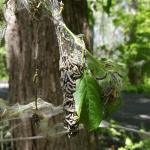
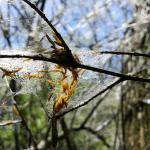

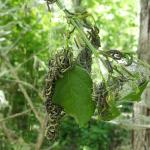
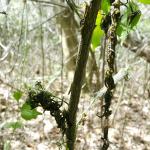
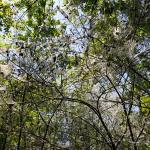
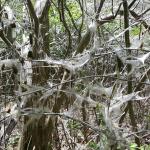
 Euonymus Caterpillar: Yponomeuta cagnagella is of European origin and widespread in distribution throughout Europe. It was first reported in North America in Ontario in 1967. As of 5/23/18, euonymus caterpillars are present, feeding and creating an ample amount of webbing at a location in Amherst, MA. The caterpillars are present by the thousands in an understory, forested area. At this location, they have eaten nearly all euonymus leaves in sight. Caterpillars were very active the morning of 5/23/18, feeding in large groups and dangling from host plant branches on webbing. The euonymus caterpillars (larvae) feed in groups and envelop the foliage of the host plant in webs as they feed. Hosts include: Euonymus europaeus (tree form), E. kiautschovicus, E. alatus and E. japonicus. Mature caterpillars are just under an inch in length, creamy yellow-gray in color with black spots and a black head capsule. By late June, these larvae pupate in white, oval-shaped cocoons which are typically oriented together vertically either on host plants or non-hosts in the area. Cocoons can be found in cracks and crevices or webbed together leaves. The adult moth emerges in late June in most locations. The adult female secretes a gummy substance over her eggs which will harden, making them even more difficult to see. Eggs hatch by mid-August, at which time the tiny larvae prepare to overwinter beneath their eggshell-like covering. These larvae are inactive until the following year, when caterpillars group together to feed on newly emerging leaves, creating a mess of webs as they feed. There is one generation per year. Plants may be partially or entirely defoliated and the plants at this location in Amherst are nearly defoliated. Management of young, actively feeding caterpillars with Bacillus thuringiensis is possible if deemed necessary, however many species of Euonymus are considered invasive themselves.
Euonymus Caterpillar: Yponomeuta cagnagella is of European origin and widespread in distribution throughout Europe. It was first reported in North America in Ontario in 1967. As of 5/23/18, euonymus caterpillars are present, feeding and creating an ample amount of webbing at a location in Amherst, MA. The caterpillars are present by the thousands in an understory, forested area. At this location, they have eaten nearly all euonymus leaves in sight. Caterpillars were very active the morning of 5/23/18, feeding in large groups and dangling from host plant branches on webbing. The euonymus caterpillars (larvae) feed in groups and envelop the foliage of the host plant in webs as they feed. Hosts include: Euonymus europaeus (tree form), E. kiautschovicus, E. alatus and E. japonicus. Mature caterpillars are just under an inch in length, creamy yellow-gray in color with black spots and a black head capsule. By late June, these larvae pupate in white, oval-shaped cocoons which are typically oriented together vertically either on host plants or non-hosts in the area. Cocoons can be found in cracks and crevices or webbed together leaves. The adult moth emerges in late June in most locations. The adult female secretes a gummy substance over her eggs which will harden, making them even more difficult to see. Eggs hatch by mid-August, at which time the tiny larvae prepare to overwinter beneath their eggshell-like covering. These larvae are inactive until the following year, when caterpillars group together to feed on newly emerging leaves, creating a mess of webs as they feed. There is one generation per year. Plants may be partially or entirely defoliated and the plants at this location in Amherst are nearly defoliated. Management of young, actively feeding caterpillars with Bacillus thuringiensis is possible if deemed necessary, however many species of Euonymus are considered invasive themselves.- Forest Tent Caterpillar: Malacosoma disstria egg hatch has occurred and caterpillars were observed on crabapple and Rhododendron spp. on 5/16/2018 in Amherst, MA. Forest tent caterpillars are significantly larger than gypsy moth caterpillars at this time. They are hairy with visible blue lateral stripes and white “key-hole” or “penguin”-shaped spots from head to hind end dorsally. Susceptible hosts whose leaves are fed on by this insect include oak, birch, ash, maple, elm, poplar and basswood.
- Hemlock Looper: Two species of geometrid moths in the genus Lambdina are native insects capable of defoliating eastern hemlock, balsam fir and white spruce. Adult moths lay their eggs on the trunk and limbs of hosts in September and October and eggs will hatch by late May or early June. Monitor susceptible hosts for small, inch-worm like caterpillars. Where populations are low no management is necessary.
- Imported Willow Leaf Beetle: Plagiodera versicolora overwintered adults are present and continue to be active and found on willow foliage. Adult beetles will chew holes and notches in the leaves of willow. Egg laying was observed on 5/16/18 and 5/23/18 in Chesterfield, MA and will continue through the end of this month. Females lay yellow eggs in clusters on the undersides of leaves. Larvae are slug-like and bluish-green in color. They will feed in clusters and skeletonize the leaves. Most plants can tolerate the feeding from this insect. Affected foliage will appear brown. Repeated yearly feeding can be an issue, in which case management of the young larvae may be necessary. Take care with treatment in areas near water.
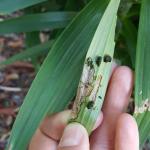 Lily Leaf Beetle: Lilioceris lilii overwintering adults continue to be active in Amherst, MA on 5/23/18. Susceptible hosts include Lilium spp. (Turk’s cap, tiger, Easter, Asiatic and Oriental lilies) and Fritillaria spp. (Note: daylilies are not hosts.) Typically mating will occur in May and each female will begin to lay 250-450 eggs in neat rows on the underside of the foliage. In Amherst, MA, orange lily leaf beetle eggs were observed on the underside of host plant foliage on 5/16/2018 and some of these eggs have hatched by 5/23/2018. Frass-covered larvae were observed feeding on 5/23/2018 in Amherst, MA. Where adults and larvae are seen, they can be removed from host plants with a gloved hand, where practical.
Lily Leaf Beetle: Lilioceris lilii overwintering adults continue to be active in Amherst, MA on 5/23/18. Susceptible hosts include Lilium spp. (Turk’s cap, tiger, Easter, Asiatic and Oriental lilies) and Fritillaria spp. (Note: daylilies are not hosts.) Typically mating will occur in May and each female will begin to lay 250-450 eggs in neat rows on the underside of the foliage. In Amherst, MA, orange lily leaf beetle eggs were observed on the underside of host plant foliage on 5/16/2018 and some of these eggs have hatched by 5/23/2018. Frass-covered larvae were observed feeding on 5/23/2018 in Amherst, MA. Where adults and larvae are seen, they can be removed from host plants with a gloved hand, where practical. - Roseslugs: Two species of sawfly can be found on the leaves of roses at this time. These small, caterpillar-like larvae will skeletonize the upper leaf surface and leave a “window-pane” like pattern behind. When present in large numbers these insects are capable of defoliating their entire host. Management options include an insecticidal soap spray or a product containing spinosad.
- Spotted Lanternfly: (Lycorma delicatula, SLF) is not known to occur in Massachusetts. The Pennsylvania Department of Agriculture reported on 5/14/2018 that spotted lanternfly eggs have begun to hatch in Berks County, PA for the 2018 season. Small, black and white spotted nymphs (immatures) are seen in PA at this time.
This insect is a member of the Order Hemiptera (true bugs, cicadas, hoppers, aphids and others) and the Family Fulgoridae, also known as planthoppers. This insect is a non-native species first detected in the United States in Berks County, Pennsylvania and confirmed on September 22, 2014. Until November 2017, this invasive insect was only known to Pennsylvania. It has now been reported from Delaware (November 20, 2017), New York (November 29, 2017), and most recently in Virginia (January 10, 2018). The Delaware Department of Agriculture announced the finding of a single female spotted lanternfly in New Castle County in the Wilmington, Delaware area. At this time, officials in Delaware note that it is unclear if this individual was an accidental hitchhiker or evidence of an established population in the state. For more information about the find in Delaware visit: https://news.delaware.gov/2017/11/20/spotted-lanternfly-confirmed-delaware/ . The New York State Department of Agriculture and Markets reported on November 29, 2017 the finding of a single dead individual spotted lanternfly in the state from earlier in the month. A single dead specimen was confirmed at a facility in Delaware County, New York, which is located south-west of Albany. The NYS Dept. of Agriculture and Markets states that this dead individual may have come in on an interstate shipment. For more information about the find in New York, visit: https://www.agriculture.ny.gov/AD/release.asp?ReleaseID=3637 . Most recently, Virginia Cooperative Extension announced the finding of a spotted lanternfly population in Frederick County, Virginia, on January 10, 2018. It was noted that at the location in Virginia, numerous adult lanternflies and egg masses were discovered, in addition to more at another site approximately 400 yards away. For more information about the find in Virginia, visit: https://ext.vt.edu/agriculture/commercial-horticulture/spotted-lanternfly.html .
The spotted lanternfly is considered native to China, India and Vietnam. It has been introduced as a non-native insect to South Korea and Japan prior to its detection in the United States. In South Korea it is considered invasive and a pest of grapes and peaches. The spotted lanternfly has been reported from over 70 species of plants including the following: tree of heaven (Ailanthus altissima) (preferred host), apple (Malus spp.), plum, cherry, peach, apricot (Prunus spp.), grape (Vitis spp.), pine (Pinus spp.), pignut hickory (Carya glabra), sassafras (Sassafras albidum), serviceberry (Amelanchier spp.), slippery elm (Ulmus rubra), tulip poplar (Liriodendron tulipifera), white ash (Fraxinus americana), willow (Salix spp.), American beech (Fagus grandifolia), American linden (Tilia americana), American sycamore (Platanus occidentalis), big-toothed aspen (Populus grandidentata), black birch (Betula lenta), black cherry (Prunus serotina), black gum (Nyssa sylvatica), black walnut (Juglans nigra), dogwood (Cornus spp.), Japanese snowbell (Styrax japonicus), maple (Acer spp.), oak (Quercus spp.) and paper birch (Betula papyrifera).
The adults and immatures of this species damage host plants by feeding on sap from stems, leaves and the trunks of trees. In the springtime in Pennsylvania (late April - mid-May) nymphs (immatures) are found on smaller plants and vines and new growth of trees and shrubs. Third and fourth instar nymphs migrate to the tree of heaven and are observed feeding on trunks and branches. Trees may be found with sap weeping from the wounds caused by the insect’s feeding. The sugary secretions (excrement) created by this insect may coat the host plant, later leading to the growth of sooty mold. Insects such as wasps, hornets, bees and ants may also be attracted to the sugary waste created by the lanternflies or to sap weeping from open wounds in the host plant. Host plants have been described as giving off a fermented odor when this insect is present.
Adults are present by the middle of July in Pennsylvania and begin laying eggs by late September and continue laying eggs through late November and even early December in that state. Adults may be found on the trunks of trees such as the tree of heaven or other host plants growing in close proximity to them. Egg masses of this insect are gray in color and look similar to gypsy moth egg masses.
Host plants, bricks, stone, lawn furniture, recreational vehicles and other smooth surfaces can be inspected for egg masses. Egg masses laid on outdoor residential items such as those listed above may pose the greatest threat for spreading this insect via human aided movement.
For more information about the spotted lanternfly, visit this fact sheet: https://ag.umass.edu/landscape/fact-sheets/spotted-lanternfly .
- Spruce Spider Mite: Oligonychus ununguis is a cool-season mite that becomes active in the spring from tiny eggs that have overwintered on host plants. Hosts include spruce, arborvitae, juniper, hemlock, pine, Douglas-fir and occasionally other conifers. This particular species becomes active in the spring and can feed, develop and reproduce through roughly June. When hot, dry summer conditions begin, this spider mite will enter a summer-time dormant period (aestivation) until cooler temperatures return in the fall. This particular mite may prefer older needles to newer ones for food. Magnification is required to view spruce spider mite eggs. Tapping host plant branches over white paper may be a useful tool when scouting for spider mite presence. (View with a hand lens.) Spider mite damage may appear on host plant needles as yellow stippling and occasionally fine silk webbing is visible.
 Taxus Mealybug: Dysmicoccus wistariae was spotted on taxus in Amherst on 5/23/18. This insect will produce honeydew and lead to sooty mold growth, yellowing of needles, and sparsely foliated plants. Eventual dieback may be possible. This species is commonly associated with taxus in New England, but can be occasionally found on dogwood, rhododendron, Prunus spp., maple, andromeda and crabapple. These mealybugs are found on stems and branches and particularly like to congregate at branch crotches. Management may be targeted between 246-618 GDD’s. Horticultural oil and neem oil may be used.
Taxus Mealybug: Dysmicoccus wistariae was spotted on taxus in Amherst on 5/23/18. This insect will produce honeydew and lead to sooty mold growth, yellowing of needles, and sparsely foliated plants. Eventual dieback may be possible. This species is commonly associated with taxus in New England, but can be occasionally found on dogwood, rhododendron, Prunus spp., maple, andromeda and crabapple. These mealybugs are found on stems and branches and particularly like to congregate at branch crotches. Management may be targeted between 246-618 GDD’s. Horticultural oil and neem oil may be used.- Viburnum Leaf Beetle: Pyrrhalta viburni is a beetle in the family Chrysomelidae that is native to Europe but was found in Massachusetts in 2004. Viburnum leaf beetle egg hatch was observed in Boston, MA on 5/4/2018. Viburnum leaf beetle larvae continue to feed and grow in size. (See Regional Reports above.) By early to mid-June, viburnum leaf beetle larvae will crawl down the host plant, enter the soil surface, and pupate. This typically occurs when the larvae are just under ½ inch in length. After pupation, by early-July, adult beetles will emerge from the soil and begin feeding on viburnum foliage again prior to mating and laying eggs. This beetle feeds exclusively on many different species of viburnum, which includes, but is not limited to, susceptible plants such as V. dentatum, V. nudum, V. opulus, V. propinquum and V. rafinesquianum. Larvae, where they are present, may be treated with a product containing spinosad. Some viburnum have been observed to have varying levels of resistance to this insect, including but not limited to V. bodnantense, V. carlesii, V. davidii, V. plicatum, V. rhytidophyllum, V. setigerum and V. sieboldii. More information about viburnum leaf beetle may be found at http://www.hort.cornell.edu/vlb/
- White Spotted Pine Sawyer (WSPS): Monochamus scutellatus will be pupating this month and adults can emerge in late May throughout July, depending on local temperatures. The first report of a white spotted pine sawyer adult came from the Asian Longhorned Beetle Eradication Program in Worcester, MA. A concerned citizen in Hampshire County, MA reported (with a photo) a white spotted pine sawyer adult on 5/22/2018. This is a native insect in Massachusetts and is usually not a pest. Larvae develop in weakened or recently dead conifers, particularly eastern white pine (Pinus strobus). However, the adult white spotted pine sawyer looks very similar to the invasive Asian Longhorned Beetle, Anoplophora glabripennis, ALB. ALB adults do not emerge in Massachusetts until July and August. Beginning in July, look for the key difference between WSPS and ALB adults, which is a white spot in the top center of the wing covers (the scutellum) on the back of the beetle. White spotted pine sawyer will have this white spot, whereas Asian longhorned beetle will not. Both insects can have other white spots on the rest of their wing covers; however, the difference in the color of the scutellum is a key characteristic. See the Asian longhorned beetle entry above for more information about that non-native insect. (And where to go to report anything suspicious.)
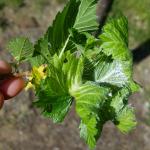
 Woolly Apple Aphid: Eriosoma lanigerum may be found on apple, crabapple, hawthorn, mountain-ash, pyracantha and elm hosts. The primary (winter) host is elm, on which aphids infest emerging spring leaf growth, causing leaves to curl or close into stunted, rosette-like clusters found at twig tips. Woolly apple aphid was observed on elm on 5/23/2018 in Amherst, MA. On apple and crabapple, this species of aphid colonizes roots, trunks, and branches in the summer and is commonly found near previous wounds or callous tissue. On roots the aphids cause swelled areas which can girdle and kill roots. The aphids, when found in above ground plant parts such as elm leaves, are covered with white wax. Eggs (overwintering on elm) hatch in the spring in time for the nymphs to infest elm foliage. Following a few generations on elm, the aphids will develop into a winged form, which will disperse and seek out apple and crabapple. Multiple generations will occur on these alternate hosts in the summer and by the fall a winged form will return to elm and mated females will lay eggs near elm buds.
Woolly Apple Aphid: Eriosoma lanigerum may be found on apple, crabapple, hawthorn, mountain-ash, pyracantha and elm hosts. The primary (winter) host is elm, on which aphids infest emerging spring leaf growth, causing leaves to curl or close into stunted, rosette-like clusters found at twig tips. Woolly apple aphid was observed on elm on 5/23/2018 in Amherst, MA. On apple and crabapple, this species of aphid colonizes roots, trunks, and branches in the summer and is commonly found near previous wounds or callous tissue. On roots the aphids cause swelled areas which can girdle and kill roots. The aphids, when found in above ground plant parts such as elm leaves, are covered with white wax. Eggs (overwintering on elm) hatch in the spring in time for the nymphs to infest elm foliage. Following a few generations on elm, the aphids will develop into a winged form, which will disperse and seek out apple and crabapple. Multiple generations will occur on these alternate hosts in the summer and by the fall a winged form will return to elm and mated females will lay eggs near elm buds.
 Woolly Beech (Leaf) Aphid: Phyllaphis fagi is a species of aphid commonly found on the leaf undersides of European beech. This is a European species that is now widely distributed throughout North America. All life stages of this particular aphid occur on beech foliage. European beech trees in North America have been observed as capable of holding large populations of this aphid year after year with little to no visible injury to the tree. Like their other aphid brethren, the woolly beech leaf aphid can create large quantities of sticky honeydew. These aphids were observed on beech in Amherst, MA on 5/23/2018. The woolly beech leaf aphid is sometimes confused with another woolly aphid, also known as the beech blight aphid (Grylloprociphilus imbricator), which is only found on American beech. G. imbricator has an alternate common name, the boogie-woogie aphid, due to a behavior where this species, when colonies are disturbed, can wiggle (or dance) together, perhaps in an effort to distract potential predators.
Woolly Beech (Leaf) Aphid: Phyllaphis fagi is a species of aphid commonly found on the leaf undersides of European beech. This is a European species that is now widely distributed throughout North America. All life stages of this particular aphid occur on beech foliage. European beech trees in North America have been observed as capable of holding large populations of this aphid year after year with little to no visible injury to the tree. Like their other aphid brethren, the woolly beech leaf aphid can create large quantities of sticky honeydew. These aphids were observed on beech in Amherst, MA on 5/23/2018. The woolly beech leaf aphid is sometimes confused with another woolly aphid, also known as the beech blight aphid (Grylloprociphilus imbricator), which is only found on American beech. G. imbricator has an alternate common name, the boogie-woogie aphid, due to a behavior where this species, when colonies are disturbed, can wiggle (or dance) together, perhaps in an effort to distract potential predators.- Woolly Elm Aphid: Eriosoma americanum females lay a single egg in the cracks and crevices of elm bark, where the egg overwinters. Eggs hatch on elm in the spring as leaves are unfolding. Aphids may be active from 121-246 GDD’s base 50°F on elm. A young, wingless female hatched from the egg feeds on the underside of leaf tissue. This female aphid matures and gives birth to 200 young, all females, without mating. These aphids feed, and the elm leaf curls around them and protects them. Curled leaves, sheltering feeding, honeydew-producing aphids within, were observed on elm in Amherst, MA on 5/16/2018 and again on 5/23/2018. By the end of June, winged migrants mature and find serviceberry hosts. Another set of females is produced. These new females crawl to and begin feeding on the roots of serviceberry. Multiple generations occur on the roots of serviceberry through the summer.
Concerned that you may have found an invasive insect or suspicious damage caused by one? Need to report a pest sighting? If so, please visit the Massachusetts Introduced Pests Outreach Project: http://massnrc.org/pests/pestreports.htm .
A note about Tick Awareness: deer ticks (Ixodes scapularis), the American dog tick (Dermacentor variabilis) and the lone star tick (Amblyomma americanum) are all found throughout Massachusetts. Each can carry their own complement of diseases. Anyone working in tick habitats (wood-line areas, forested areas and landscaped areas with ground cover) should check themselves regularly for ticks while practicing preventative measures. Have a tick and need it tested? Visit the web page of the UMass Laboratory of Medical Zoology (https://www.tickreport.com/ ) and click on the red Test a Tick button for more information.
Reported by Tawny Simisky, Extension Entomologist, UMass Extension Landscape, Nursery, & Urban Forestry Program
Weeds
Tree seedlings are continuing to germinate and some locations may have seedlings that are 2 to 3 inches tall. These seedlings can be treated with pelargonic acid, Scythe. Another option would be to cut these seedling with a gas-, electric- or battery-powered hedge shear at the soil or bark mulch surface. The organic/non-chemical products do not translocate and will produce effective control of these young tree seedlings. Red maple seedlings are often the most common species of tree seedling. Seedlings in lawn areas will be managed by mowing and no action, mechanical or chemical, is required.
Treat garlic mustard, Alliaria petiolata, now. Garlic mustard is a biennial and applications at this time of year will control second year plants before they go to seed as well as first year seedlings. Look for seedlings at this time as these seedlings will be next year’s flowering plants.
Japanese knotweed, Polygonum cuspidatum, has begun to emerge from rhizomes. Do not attempt to control this weed at this time as herbicide applications are not effective. Repeat cutting or mowing can be used as a non-chemical strategy and if that is the control strategy selected then cutting and mowing should begin now. Repeat cutting or mowing should be done as regrowth reaches 4 to 6 inches.
Inspect areas of landscape where new trees or shrubs, especially those that were field grown, have been planted in the last year. Look for perennial weeds that may be growing from the root ball. Canada thistle, mugwort, quackgrass, bindweed and horsenettle are some of the possible culprits. Applications of glyphosate as a directed spray should be done at the first sign of new season growth.
Treat winter annual and perennial weeds in ornamental beds with glyphosate (Roundup Pro or equivalent) and glufosinate (Finale). These applications are easier if done now before woody ornamentals leaf-out. The new growth of herbaceous perennial ornamentals can be very susceptible to spray drift, so exercise extreme caution. Non-chemical products containing clove oil, citric acid, acetic acid or orange extract can be used on small winter annuals but not on large winter annuals or perennials. Remember these organic/non-chemical products do not translocate and will not control established perennial weeds but will control young winter annual weeds. Many winter annuals are just beginning to flower and have not set seed and should be controlled now.
Landscape mulch should be the first defense against weeds in landscape beds. Application of mulch can be done at the beginning of the season before summer annual weeds germinate. Freshly mulched landscape beds will not require a preemergence herbicide application because the fresh mulch should supply adequate control of summer annual weeds in the short term. Preemergence herbicide application should be considered for mulch areas that have not been freshly mulched or a bit later in the season. Preemergence herbicides should be applied on top of landscape mulches not underneath. Freehand (dimethenamid + pendimethalin) or Tower (dimethenamid only) are great product choices for landscape beds where yellow nutsedge is a problem.
Report by Randy Prostak, Weed Specialist, UMass Extension Landscape, Nursery and Urban Forestry Program
Plant of the Week
The common name for this Viburnum comes from the two rows of lacecap flowers along either side of the horizontal stems. https://extension.umass.edu/plant-identification/doublefile-viburnum
Report by Mandy Bayer, Extension Assistant Professor of Sustainable Landscape Horticulture, UMass Stockbridge School of Agriculture
Additional Resources
To receive immediate notification when the next Landscape Message update is posted, be sure to join our e-mail list and follow us on Facebook and Twitter.
For a complete listing of upcoming events, see our Upcoming Educational Events page.
For commercial growers of greenhouse crops and flowers - Check out UMass Extension's Greenhouse Update website
For professional turf managers - Check out Turf Management Updates
For home gardeners and garden retailers - Check out home lawn and garden resources. UMass Extension also has a Twitter feed that provides timely, daily gardening tips, sunrise and sunset times to home gardeners, see https://twitter.com/UMassGardenClip
Diagnostic Services
A UMass Laboratory Diagnoses Landscape and Turf Problems - The UMass Extension Plant Diagnostic Lab is available to serve commercial landscape contractors, turf managers, arborists, nurseries and other green industry professionals. It provides woody plant and turf disease analysis, woody plant and turf insect identification, turfgrass identification, weed identification, and offers a report of pest management strategies that are research based, economically sound and environmentally appropriate for the situation. Accurate diagnosis for a turf or landscape problem can often eliminate or reduce the need for pesticide use. For sampling procedures, detailed submission instructions and a list of fees, see Plant Diagnostics Laboratory
Soil and Plant Nutrient Testing - The University of Massachusetts Soil and Plant Nutrient Testing Laboratory is located on the campus of The University of Massachusetts at Amherst. Testing services are available to all. The function of the Soil and Plant Nutrient Testing Laboratory is to provide test results and recommendations that lead to the wise and economical use of soils and soil amendments. For complete information, visit the UMass Soil and Plant Nutrient Testing Laboratory web site. Alternatively, call the lab at (413) 545-2311.
Ticks are active at this time! Remember to take appropriate precautions when working and playing outdoors, and conduct daily tick checks. UMass tests ticks for the presence of Lyme disease and other disease pathogens. Learn more
